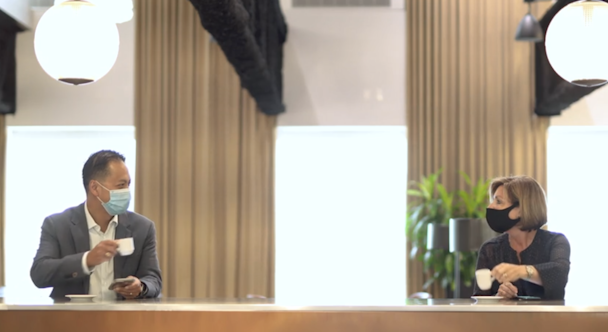Goodbye open-plan offices, hello ‘de-densification’
When employees do return to the office, things are going to look very different. Temporary satellite offices closer to home, socially distanced conference rooms, flex floors and desk dividers are just some of the new plans being drawn up.

Coffee breaks aren't what they used to be
Returning to work, in some capacity, is picking up momentum among financial services and other sectors within the US. At some point, there will be a seminal moment when a critical mass of employees reenter the office at the same time. The decision about when that is going to happen varies according to country and company, but there is one commonality: preparation is underway.
JLL, which is one of the largest commercial property companies in the world, is on the front lines of helping clients reimagine what the present day and future office must look and feel like.
Safety is, of course, the primary concern during the current “slow and methodical return to the office,” says the company’s chief marketer for the Americas, Jill Kouri. But there are also economic and high-level strategic decisions at play. “Some companies are saying: ‘How can we possibly “think different“ like Apple or invent the new device if people are sitting at home working at their kitchen tables?‘ We really want and need to have human interaction again.”
The trick is going to be how to get people to work together in a way that increases collaboration but decreases the fear factor. This means an extensive retooling of existing space to meet the needs of a pandemic-stricken workforce. At the center of conversations between JLL and its clients is the concept of ‘de-densification‘.
Were walls really such a bad thing?
The invasion of the open-plan office had been happening for more than a decade. Now, companies are “walking it back” as they work to create spaces that meet appropriate social distancing guidelines, says Kouri. These spaces are being recreated with a hybrid workforce (some people at home, some in the office) in mind. “You might occupy the same amount of space that you had before, but you will have fewer people in that space at any given time. Even post-vaccine, there‘s going to be a lingering impact of people wanting to maintain five or six feet from one another in whatever space they‘re in.”
Here are some of the alterations that are being actively discussed:
-
Capacity guidelines are changing in all of the different rooms and spaces.
-
Physical demarcations are being placed in large conference rooms, indicating where people can sit around the table.
-
Temporary dividers are being erected.
-
Workspaces are being redesigned to accommodate half the number of people. “There are completely new fit-outs for space. It could mean having desks for eight people in a space that used to hold 16.” JLL is leveraging occupancy data and space utilization software to re-imagine office layouts for its clients on the fly.
-
Office tech is getting upgraded across the board. Whether that‘s increased use of video calls or virtual collaboration tools, “it‘s all under the banner of acceleration“, says Kouri. “A lot of these things were in the works anyway, but things really have accelerated at such a rapid pace.”
Satellite offices in the suburbs and ‘flex floors’
Conversations about “hub and spoke” models are picking up steam among JLL clients. What this means is that a company with its headquarters in Manhattan, for example, will retain that office, but will also have temporary satellite offices in Jersey City, Westchester, Long Island City and areas of Connecticut. The goal is to allay the anxiety of having to get on a subway train or hustle down a bustling avenue.
“That is absolutely a trend we are seeing. It is prudent right now to think about some short-term leases, especially for city commuters.“
“Flex floors” are also increasingly entering the conversation. Whether it’s two floors or a half of a floor, businesses are looking to create flex spaces that they can lease out to individuals or other companies that are in the building “who want to leverage a common meeting space or even ancillary desk space when they have overflow”, says Kouri. “You’re going to see more of a push toward these investor owner-operated flex spaces that companies can use on an as needed basis. It’s something we’re already seeing actually.”
How JLL is helping the re-imagination process
Recognizing the challenges at hand and the pressures on businesses to make good decisions, JLL has been aggressively offering research and guidance during this complex moment centered around the theme of ’reimagination’.
This includes content marketing partnerships with Harvard Business Review and the Society for Human Resource Management. The goal is to help clients think about the future of the office and what their re-entry strategy might look like. “We’re trying to help companies think about the key factors they need to consider as they reimagine what the ‘next normal’ is going to be like for their organization.”
To help its own workforce adjust, JLL recently launched an internal campaign entitled Step Forward. It helps employees understand exactly what their re-entry journey will look like, with leaders from JLL discussing the safety precautions being taken and what employees can expect in the future.
To keep up with all our dedicated US coverage, sign up for the free daily briefing newsletter.


